Your Ecommerce D.A.R.E. for the New Year

There are 1.671 trillion reasons that companies are selling to consumers online as that is the amount of sales expected when the final 2015 figures are in.
Retailers have, of course, opened their inventory to the Web and even manufacturers and distributors are providing access to their products directly to shoppers - alongside more traditional sales channels. While there is clear opportunity for enterprises marketing and selling their products online, the digital elephants (think Amazon, Zappos and others) present a major challenge. Amazon reported recently that it shipped to 185 countries this holiday season and added 3 million new Prime members in the third week of December alone (although it should be noted that Amazon offers a free 30-day Prime trial, so that number is pretty inflated when it comes to who remains on the membership program).
While most retailers will not be able to offer Amazon perks like free same- or one-day shipping to members or its vast product gallery and low prices, consumers are still willing to go elsewhere for good products, good experiences and good service; retailers simply need to D.A.R.E. to compete and increase their digital footprint by catering to what modern shoppers expect.
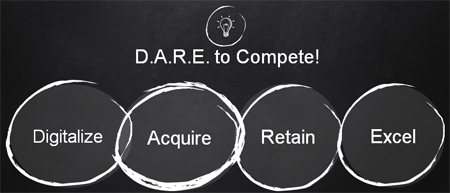
Digitalize
Today's consumer - whether it's a millennial or a baby boomer - wants access to brands when, where and how they want. For example, both demographics love coupons, bargains and sales, as well as are very comfortable with online shopping, browsing and researching.
From websites and marketplaces to social media and offline channels, modern companies clearly need active presences everywhere their shoppers are. It's, of course, not enough to simply set and forget a channel, brands must actively optimize their efforts through what they have learned about their customers' preferences, their competitors' failures/successes and industry changes as a whole. Here are expectations customers have for the various channels they find themselves on:
Website Expectations
x Mobile Friendly
x Prominent Contact Info
x Loads Quickly
x Clear Navigation
x Site Search
x Easy Registration
x Social Login
x Uncluttered
x Concise Copy
x Modern Look/Functions
x Guest Checkout
x Upfront Shipping $$
x Promotional Offers
x Trust Seals
x Peer Ratings/Reviews
x Preferred Language
x Payment Options
x Personalized
Marketplace Expectations
x Beautiful Product Imagery
x Awesome Customer Service
x Surprising Packaging
x Searchable
x Same as Website Expectations
Social Media Expectations
x Presence on Multiple Networks
x Complete Profiles
x Business Photos
x Consistent Content
x Relevant Posts
x Authoritative Tone
x User Involvement
x Customer Service
x Responsive
x Inside Look
x Network-Specific Content
x Post-Click Friendly (optimized for device, relevant to click)
x Exclusive Promotions
Offline Expectations
x Knows Order History
x Can Make Recommendations
x Same Promotions as Online
x Inventory Access Across Channels
x Order Online, Pick Up in Store
x Consistent Prices
x Robust Product Info
Acquire
With a robust digital presence, a brand must actively acquire new customers by driving them to their Web properties, most importantly their website where conversions can happen. Organic search, email marketing and social media remain the top three ways to drive website traffic. This is because organic search drives 51 percent of website traffic, email returns a $43 ROI for every dollar spent and social media marketing is considered "extremely effective" by 92 percent of marketers. Here are some best practices and expectations for each of these channels:
SEO Expectations
Note: Many of the expectations that search engines have for how a website should function are the same as consumers' expectations of how a website should function.
x Mobile Friendly
x Loads Quickly
x Fresh, Quality Content
x Authoritative
x Inbound Links
x Outbound Links
x Relevant
x Good UX
X Technical Considerations
While these SEO expectations are by no means an exhaustive list, they're a very good start when it comes to ensuring users and search engines can access content quickly (look to tools like Dynatrace and Google's Page Insights to analyze your site's current load time) regardless of device, that the site has other sites vouching for its credibility and that it will provide a good experience once a person has clicked through from the search engine result pages (SERPs). To help with a company's efforts, Web professionals should look to tools like SEMrush for competitive data and what their current link profile looks like, BuzzSumo for an analysis of the type of content that is being shared and by whom and heatmapping tools to understand where users might be experiencing friction in their user experience.
Email Expectations
x Mobile Friendly
x Large Call to Action
x Fresh, Quality Content
x Authoritative
x Consistent
x Social
x Links Work
x Content Prioritized
x Personalized
x Retargeted
x Discounts
x Informational
x Mimics Website Navigation
The following email marketing campaign from thredUP, an online consignment store, meets many of the expectations listed above; it offers a large call to action (with contrasting colors), a promotional code for first-time buyers, a referral offer to earn $10, mobile-friendly formatting, information on the brand and clear navigation options that mimic the website.
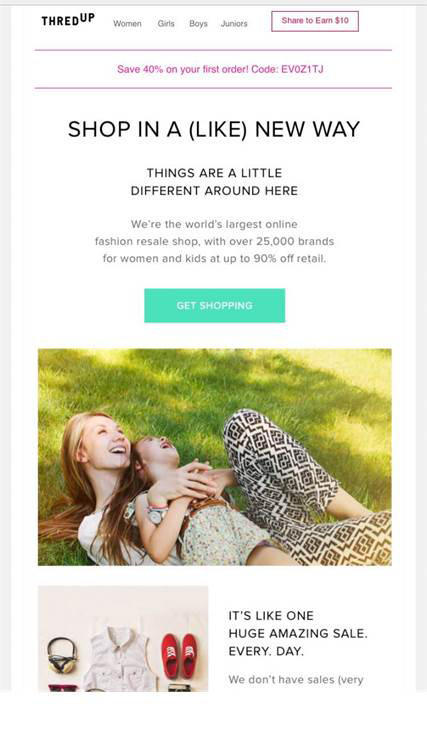
Social Media Expectations
While consumers' expectations for how a brand should behave on social media networks is listed above, when acquiring customers on social networks, a brand may not have to look farther than its own active audience. A company should encourage its customers to share their products on social media by providing an appropriate hashtag, holding contests and/or repurposing user generated content for blogs or other posts to build the incentive of sharing content. These UGC wins from the holiday season can help spark a company's own initiative to encourage users to share their brand experiences.
Retain
It's long been reported that new customers cost five times more to acquire than it does to retain existing ones, yet most marketing dollars still go to acquiring new customers rather than activating current ones. Email, rewards and customer service are three ways to keep shoppers onboard.
Customer Retention via Email
When crafting and sending emails to previous buyers there are some campaigns to consider:
x Educational
x Transaction-Based
x Feedback Requests
x Behavior Driven
x Referral Promotions
Behavior-driven email campaigns, specifically, can prove quite beneficial to retailers, as proven recently by Mood Fabrics (often highlighted in the TV Show "Project Runway"). Enlisting the help of Listrak, Mood identified three customer segments that require different products and different content: clothing designers, DIY shoppers and home sewers.
Listrak then automated product selection for the emails based on the products shoppers viewed or had previously purchased.
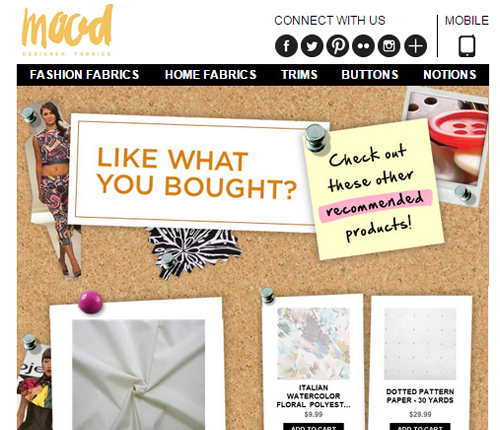
Spending about $3,000-$5,000 a month on its Listrak services (depending on how many emails it sends), Mood benefited from the following increases in KPIs with these behavior-driven recurring email campaigns (detailed more here):
x 14 percent higher conversion rate
x $5 higher AOV
x Accounted for 5 percent of all online revenue
x 7.23 percent conversion rate overall
Customer Retention via Rewards
The most common types of reward programs are those that are point based or use tier systems, while reward programs that require paying upfront fees for exclusive services (like Amazon Prime) are on the rise.
When launching a point-based rewards program, it's crucial to consider social-media sharing options as a way to earn points. PunchTab found that socially engaged consumers buy two times more and three times more often. BirchBox offers a point-based rewards program in which the points can be redeemed for products in its online store. Members can earn more points when they share pictures of the products online, invite friends to join and provide product reviews, as well as, of course, buy products.
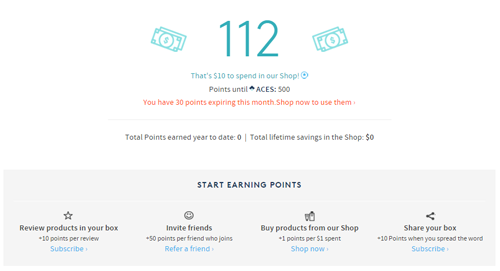
Customer Retention via Service
As mentioned, customers want access to a brand whenever they need it and whatever channel they happen to be on - requiring brands to actively listen to brand mentions across the Web, particularly on social media channels. Further, they increasingly expect self-service options with the majority preferring to help themselves over speaking to a company representative.
Self-Service Options
x Live Chat
x Peer Q&A
x Online Schedulers
x Document Sharing
For example, baby monitor, Owlet, uses Needle to leverage brand advocates and experts to answer questions via live chat on their website. This helps remove barriers to conversions because it's a unique product that an active user will know more about than a typical call center or live chat agent.
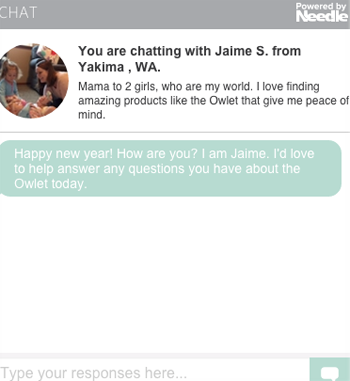
Customer Service via Social Media
Brands must use a social media platform (e.g. Sprout Social, Hootsuite) to listen and respond to conversations around their brand. Further, they should try to move any complaints off of social media to a more private setting (like a direct message or an email). Technology that is complementary to their social media platform should also be considered, like Social Mention, which analyzes social mentions for sentiment as well and top users.

Excel
When daring to compete online, there are three things that truly matter: experience, experience, experience. The consistent, relevant, authoritative, fast, personalized, modern and quality experience that a company provides on their website, should be provided through their email, social and search engine marketing as well. Experience is what sets apart one digital property from the next and is where time and money should be spent.
D.A.R.E.
Investing into digitalizing a company to cater to modern consumer expectations at every phase - acquisition through retention - will allow any brand big or small to excel online.








